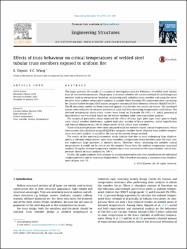| dc.contributor.author | Özyurt, Emre | |
| dc.contributor.author | Wang, Yong Chang | |
| dc.date.accessioned | 2019-12-18T11:02:26Z | |
| dc.date.available | 2019-12-18T11:02:26Z | |
| dc.date.issued | 2015 | |
| dc.identifier.uri | https://hdl.handle.net/20.500.12440/1778 | |
| dc.identifier.uri | https://www.sciencedirect.com/science/article/pii/S0141029615000474?via%3Dihub | |
| dc.description.abstract | This paper presents the results of a numerical investigation into the behaviour of welded steel tubular truss at elevated temperatures. The purpose is to assess whether the current method of calculating truss member limiting temperature, based on considering each individual truss member and using the member force from ambient temperature analysis, is suitable. Finite Element (FE) simulations were carried out for Circular Hollow Section (CHS) trusses using the commercial Finite Element software ABAQUS v6.10-1. The FE simulation model had been validated against available fire test results on trusses. The simulated trusses were subjected to constant mechanical loads and then increasing temperatures until failure. The elevated temperature stress–strain curves were based on Eurocode EN-1993-1-2. Initial geometrical imperfections were included, based on the lowest buckling mode from eigenvalue analysis. The numerical parametric study examined the effects of truss type, joint type, truss span-to-depth ratio, critical member slenderness, applied load ratio, number of brace members, initial imperfection and thermal elongation on critical temperatures of the critical truss members. These critical temperatures were then compared with the member-based critical temperatures, which were numerically calculated using ABAQUS but using the member forces obtained from ambient temperature structural analysis as would be the case in the current design method. The results of the numerical parametric study indicate that due to truss undergoing large displacements at elevated temperatures, some truss members (compression brace members near the truss centre) experience large increases in member forces. Therefore, when calculating the member critical temperatures, it would not be safe to use the member forces from the ambient temperature structural analysis. Using the ambient temperature member force may overestimate the truss member critical temperature (based on truss analysis) by 100 C. Finally, this paper proposes and validates an analytical method to take into consideration the additional compression force due to large truss displacement. This is based on assuming a maximum truss displacement of span over 30. | en_US |
| dc.description.sponsorship | The authors would like to acknowledge CIDECT for partially funding this project, under the CIDECT project: 5CB-Uniformly
Heated Truss. | en_US |
| dc.language.iso | eng | en_US |
| dc.publisher | Engineering Structures | en_US |
| dc.rights | info:eu-repo/semantics/closedAccess | en_US |
| dc.subject | [No Keywords] | en_US |
| dc.title | Effects of truss behaviour on critical temperatures of welded steel tubular truss members exposed to uniform fire | en_US |
| dc.type | article | en_US |
| dc.relation.publicationcategory | Makale - Uluslararası Hakemli Dergi - Kurum Öğretim Elemanı | en_US |
| dc.department | Fakülteler, Mühendislik ve Doğa Bilimleri Fakültesi, İnşaat Mühendisliği Bölümü | en_US |
| dc.contributor.institutionauthor | Özyurt, Emre | |


















